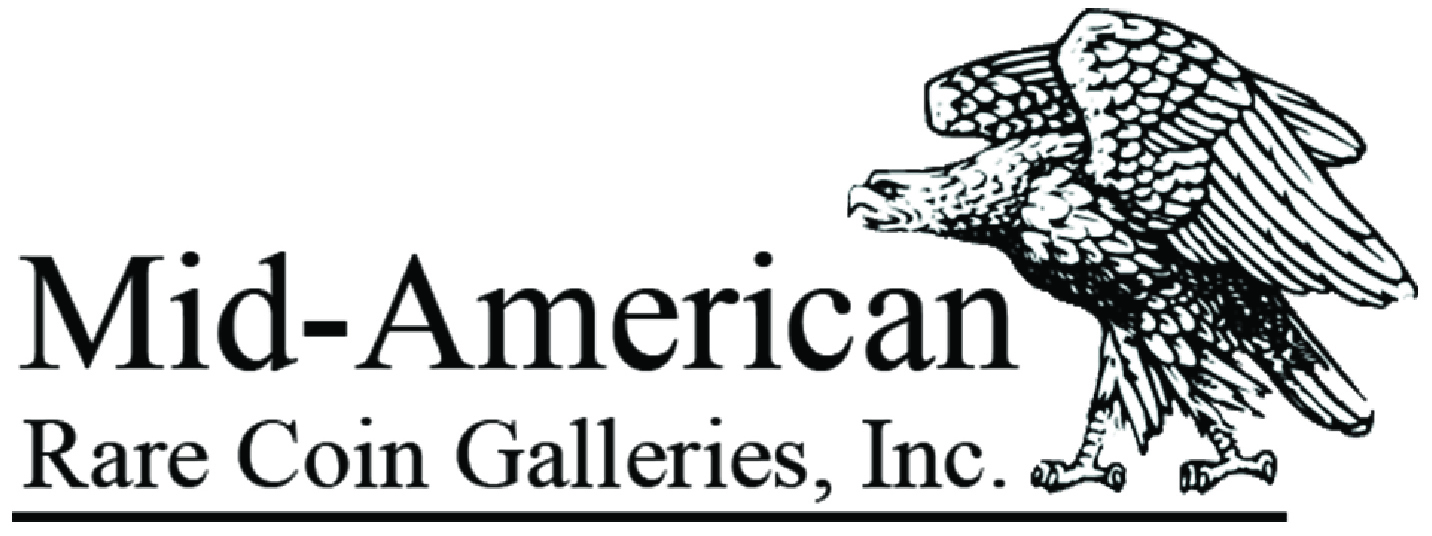Among the most short-lived series of United States coins are the Twenty Cent pieces struck from 1875 to 1878. Although the coins were made for a very short time, the series contains several interesting and, in some cases, very rare issues. Collectors usually seek examples of this series for Type collections and, surprisingly, few attempt to assemble a complete set. Usually, serious aficionados collect Twenty Cent pieces by date and mintmark of this Liberty Seated series.
The origins of the series began with the United States Government’s need to absorb the prodigious quantities of silver being mined in the western parts of the country. The discovery of the Comstock Lode in Nevada eventually created pressure on the price of silver in the world markets. One solution was to use the silver for coinage.
Mint Director Henry Linderman worked with politicians of the era to promote legislation for the Twenty Cent coin. One reason stated for the new denomination was to facilitate commerce because of the discontinuation of the half dime. Shoring up the silver market for Western interests was certainly the stronger motivation.
Liberty Seated coinage, which began in 1836, was designed by Christian Gobrecht. Mint Director Linderman instructed Charles Barber to design the new denomination. In 1875, Charles Barber designed and produced several very interesting pattern Twenty Cent specimens. These are all highly collectible but rarely appear for sale.
One of the most obvious objections to the new design would have been the confusion with the circulating Seated quarters of the time. Why the Mint chose the Liberty Seated design, which closely resembles the Seated quarter design, is vexing. The pattern designs offered by Charles Barber would have at least given the new denomination a fighting chance. Despite the coin having a plain edge, similarities doomed the issue. The Mint made a similar error of judgment with the Susan B. Anthony dollar about 100 years later. That series, too, was short-lived.
Twenty Cent pieces were struck in San Francisco, Carson City, and Philadelphia. The coins range from easily available to extremely rare. The following date-by-date analysis will give readers an idea of each coin’s rarity and collectability.
Business Strike
1875 Philadelphia, Mintage: 38,500
The mintage for the Philadelphia issue is tiny in comparison with its San Francisco counterpart. The issue is available in Circulated grades but is somewhat scarce. Only about 200 to 300 have been graded by NGC in the Circulated grades. Most of the Mint State coins seen are MS 61 to MS 63. Because of its first-of-issue status, several superb examples exist, with the finest being five coins certified by NGC as MS 67. The last NGC MS 67 sold in 2014 for over $22,000. High-grade 1875 Twenty Cent pieces are quite confusing, even for experts. Many are seen with deep, Prooflike surfaces, and it’s very hard to determine the exact status of their production. Proofs of the series are quite different than the later issues.
1875 Carson City, Mintage: 133,290

Despite the much higher mintage than its Philadelphia counterpart, the 1875-CC Twenty Cent is relatively similar in rarity in most grades. There are more low-grade examples known, as the issue saw extensive circulation in the West. The population of lower-grade coins is somewhat higher. Mint State coins are easily available as a few hundred have been graded at that level.
As with any Carson City coinage of the era, they are quite popular in all grades, and the prices reflect that. Gem examples of the 1875-CC Twenty Cent are very elusive. Only 31 have been graded MS 65 and just five at the MS 66 level. A single MS 67 coin survived and that coin sold at auction in 2017 for $52,875 USD. It should be noted that the majority of 1875-CC Twenty Cent pieces are very weakly struck on the reverse. This can make grading the issue problematic. The above-mentioned MS 67 coin is beautifully toned and well-struck.
1875 San Francisco, Mintage: 1,155,000
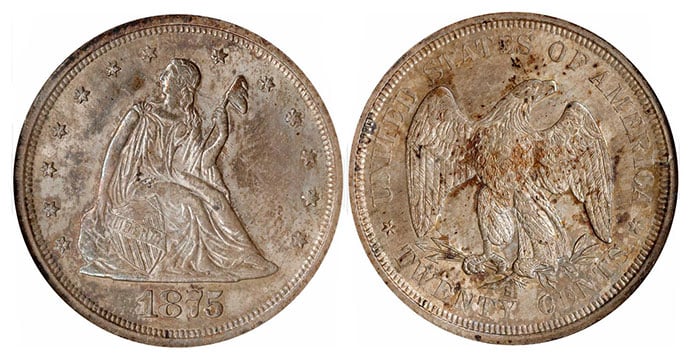
Given the coin’s gigantic mintage, it goes without saying that this is the most common Twenty Cent piece. Most collectors seeking an example for a Type set would choose this date based on availability and affordability. The coin can be found in all grades below Gem with ease. Finding an attractive coin with good eye appeal would be the bigger challenge. As any advanced Type collector can tell you, the Twenty Cent piece is difficult to locate in Gem or Superb condition.
NGC has certified 203 as MS 65 or MS 65+, and just 54 at the MS 66 level. Only nine coins have achieved MS 67 status, and the finest graded remains a single MS 68. This issue is blessed with a good strike and, in many cases, a booming mint luster. Examples are also seen with Prooflike surfaces. As always, try to find one with good eye appeal.
There is an interesting and collectible variety for this year: the 1875-S/S. This variety actually touts two mint errors in one. The first error is a misplaced date that shows up as a bar in the denticles below the “7” of the date. The second error for the coin is a double punching of the mintmark. This variety only brings a small premium, and many certified examples do not note the variety on the label.
1876 Philadelphia, Mintage: 14,750

By this time, the demand for the issue had never materialized, and the small mintage reflects the lack of interest in the new denomination. Furthermore, Twenty Cent pieces were heavily melted in later years. The 1876 is quite scarce in all grades and is similar in rarity to the 1875-CC. Many survivors of this issue were probably saved by visitors to the 1876 Centennial celebration in Philadelphia. The 1876 Twenty Cent is an underrated issue in my opinion. NGC has graded 36 coins as MS 65 and only 17 and MS 66 or MS 66+. Just three examples met the criteria for MS 67, and none of these have sold at auction for more than a dozen years.
1876 Carson City, Mintage: 10,000 (Nearly All Melted)

This issue is a mega rarity and not considered collectible by all but the wealthiest collectors. For generations, the 1876-CC Twenty Cent was mentioned as one of the great US coins alongside the 1804 Dollar, the 1913 Liberty nickel, and the 1894-S dime. The coin is included in my book, 100 Greatest U.S. Coins, and states the following:
The twenty-cent piece is one of those well-intentioned coins for which the Mint will be perpetually embarrassed. The new denomination was intended to halt chronic short-changing in the Western states, but was more likely an appeasement to Western silver miners who lost much of their business when the Mint eliminated some of the silver coins in the Coinage Act of 1873. The twenty-cent piece was basically dead on arrival. Critics derided the confusing similarity between the new coin and the quarter dollar. In a classic “history is destined to repeat itself” moment, the Mint made a similar mistake in 1979 by introducing the ill-fated Susan B. Anthony dollar (also confused with the quarter dollar). As a result, the twenty-cent piece was made for circulation only in 1875 and at the beginning of 1876; Proofs were made from 1875 to 1878.
Although the series was short-lived, from it sprang one of America’s most famous rarities: the 1876-CC twenty-cent piece.
Early in 1876, approximately 10,000 1876-CC twenty-cent pieces were struck and placed in the Mint’s vault awaiting release into circulation. In the meantime, Mint officials in the East realized their mistake in creating the new denomination and ordered the destruction of all of the existing stocks of twenty-cent pieces, including the 10,000 (or so) 1876-CCs. The melted silver was later turned into other coins, and it’s interesting to consider that coins exist that were made from a reconstituted 1876-CC twenty-cent piece.
Somehow, a few 1876-CC twenty-cent pieces escaped the melting pot. Some may have been saved for the annual package of assay coins, originally destined for metallurgical testing back in Philadelphia. However, the number of survivors is greater than the number of coins normally set aside for the Assay Commission, indicating that Mint employees pulled additional examples from the melt.
Today, the roster of survivors includes anywhere from 12 to 20 coins, depending on who performs the survey. Most of the known examples are in Uncirculated condition, although at least one example is circulated (could this piece have been pulled from circulation by some lucky collector, or was it carried as a pocket piece?).
All 1876-CC twenty-cent pieces show a doubling of the word LIBERTY on the scroll across the shield on the coin’s obverse. This makes it easy to detect 1876 Philadelphia coins with fraudulently added mintmarks, none of which show similar doubling.
Proofs
1875 Philadelphia, Mintage: 1,200
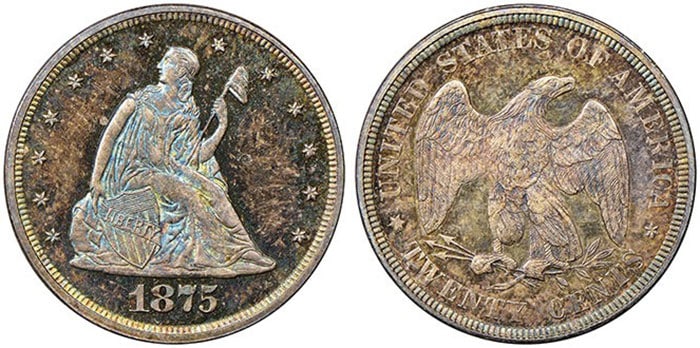
As mentioned in the text for the business strikes of this year, it can be very difficult to distinguish Proofs and Circulation strike coins. True Proofs have broad rims, and the edges are fully mirrored. The mintage of 1,200 is misleading as many must have been melted based on the number of survivors. NGC has graded less than 200 in all states of preservation. An examination of auction records shows that several examples in grades from PF 63 to PF 65 sell each year. NGC has certified 21 coins as PF 66, with one that sold for $7,200 in August 2022 (which seems like a great deal for such a rare coin). The finest coins graded by NGC are five coins graded PF 67, the last selling for $26,400 in January 2022.
1875-S Branch Mint Proof
When the denomination was first introduced, the United States Mint struck a small number of examples that experts now recognize as Branch Mint Proofs. I have handled a couple of these over the years, and they both displayed very broad rims and deep mirror reflectivity. Experts disagree on the status of these quite often, and it is highly recommended to only purchase a certified example. NGC has only certified two PF 63 examples as Branch Mint Proofs for the year. None have sold at auction in recent years.
1876 Philadelphia, Mintage: 1,150
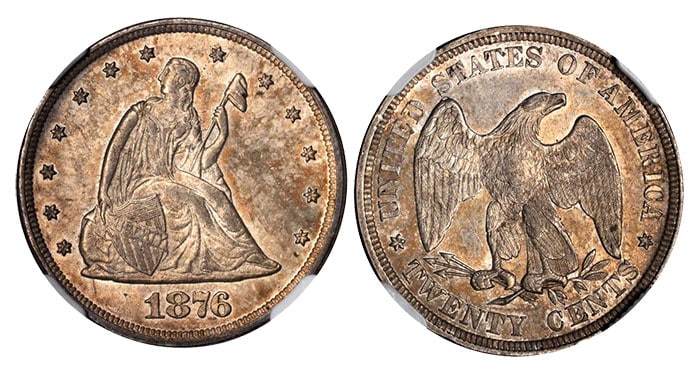
With a very similar mintage to the 1875 Proof coins, this date can be found with about the same regularity. The only difference is that a few coins survived and are in amazing PF 68 condition. These coins are superb and were probably once part of an original Proof from the era. One of these coins last sold for $23,500 in 2016.
My only word of caution for this issue is that many do not have great eye appeal and are darkly toned. Cameo examples add considerably to the desirability of the issue. Some coins are so darkly toned that it is impossible to see the Cameo contrast. More than a few have been to achieve the added designation.
1877 Philadelphia, Mintage: 510
By 1877, the Twenty Cent denomination had met its end as a circulating coin. This did not stop the US Mint from still producing coins for the healthy collector market of the time. The 1877 Twenty Cent is considered the scarcest of the Proof-only Twenty Cent pieces. This is proven correct by the number of coins graded for each date by NGC of each date:
- 1877: 270 coins
- 1878: 325 coins
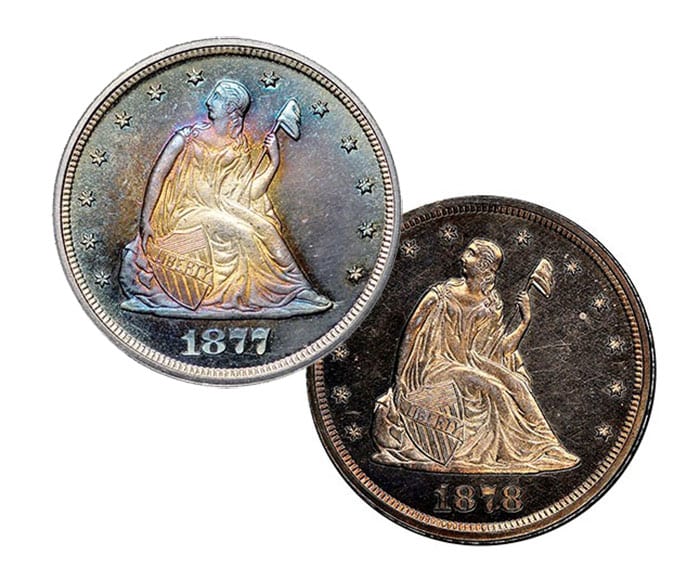 The price difference for the two coins is substantial, however, and is the result of at least one collector hoarding the issue. Prices for 1877 Proof Twenty Cent coins soared a few years ago to unprecedented levels. Coins were selling for double that of a few years earlier. Apparently, these coins are now re-entering the market, and recent prices have come down to more historical levels. Caution should be used when purchasing an example of the date — check the current auction records for price levels. Despite being a Proof-only issue, the date is often seen in Circulated grades. Obviously, quite a few were spent at one time. The finest grades for the date by NGC are six coins at the PF 67 level, three of which have Cameo designations.
The price difference for the two coins is substantial, however, and is the result of at least one collector hoarding the issue. Prices for 1877 Proof Twenty Cent coins soared a few years ago to unprecedented levels. Coins were selling for double that of a few years earlier. Apparently, these coins are now re-entering the market, and recent prices have come down to more historical levels. Caution should be used when purchasing an example of the date — check the current auction records for price levels. Despite being a Proof-only issue, the date is often seen in Circulated grades. Obviously, quite a few were spent at one time. The finest grades for the date by NGC are six coins at the PF 67 level, three of which have Cameo designations.
1878 Philadelphia, Mintage: 600
The 1878 Twenty Cent is very popular for its net low mintage. Proof-only coins from this era are highly sought after by collectors, and the issue is always in demand. Despite its somewhat higher mintage, the 1878 is actually seen less often in Superb condition than the 1877 issue. The last PF 67 1878 Twenty Cent sold in 2017 for $23,000. This issue is also seen in Circulated grades quite often.
For a short series, Twenty Cent pieces can be quite challenging but a fun one to collect. Don’t let the presence of the mega-rare 1876-CC stop you from collecting this interesting coin. Collectors could also consider adding some of the elusive Patterns for the issue by Charles Barber. Some of these are of about the same rarity as the 1876-CC but sell for a fraction of the price. You may later consider some of the other “odd denominations” such as the Three Cent nickels and silvers.
